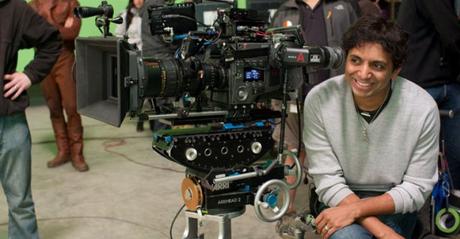
After two financially successful films in a row, is it safe to no longer regard M. Night Shyamalan as being on the comeback? With 2015's The Visit being his first film to turn a profit in its opening weekend alone and Split currently dominating the competition at the box office, is he just officially back at this point? Or will we never truly forgive/forget Lady in the Water and The Happening and always cast a skeptical eye at anything bearing his name? Is Shyamalan always one poorly executed twist away from another box office embarrassment?
Only time will tell, but let's pause a moment to appreciate the re-emergence of the man who once could seemingly do no wrong.
Not that I would have thought so if you would have asked me about Shyamalan in the early 2000s. Off the back of Sixth Sense, Unbreakable and Signs, he was hailed as "the next Spielbeg" or "next Hitchcock" or both. He was at the forefront of an insanely promising new batch of directors, held in even higher esteem by some than Darren Aronofsky, David O. Russell and Spike Jonze. At the very least, he was the most commercially successful of the bunch.
And, sure, I had been swept up in The Sixth Sense craze, just like everyone else, but I was also that snarky guy went to see Unbreakable and Signs with his friends and quipped, "Oh, what a surprise, another Hitchcock-like cameo and twist ending. That's real original." Moreover, both films just struck me as so overly ponderous and self-indulgent, particularly the painfully slow-moving Unbreakable.
Shyamalan's Box Office Rise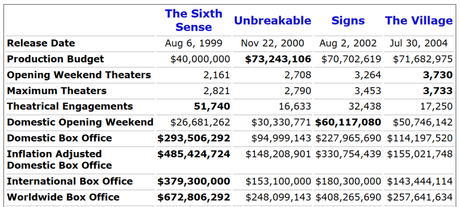
Deep down, I was likely just lashing out a commercially successful director, falling prey to the snobbish tendency to conflate popular (and increasingly predictable) with bad. It thus gave me some perverse joy to see Shyamalan turn into a punch line, beginning with The Village before absolutely bottoming out with the one-two punch of crap we call Lady in the Water and The Happening. See, I was right the whole time. Shyamalan was always just a magician who talked a good game but only really knew the one card trick.
Shyamalan Levels Off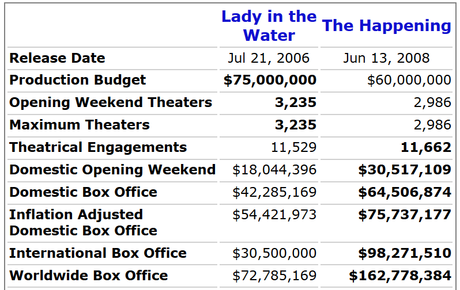
Now, I look back and remember just how amazing Sixth Sense really is, and how much there is to admire about Unbreakable, Signs and even Village. The Film Theorists on YouTube recently broke down how Shyamalan's twists grew lazier in their execution over time, arguing it was poor execution not just repetition which turned us against his twists, and they're not entirely wrong. However, because of how quickly he became a joke after the Village it's hard to remember a time when Shyamalan was considered one of the elites. After all, anyone who has ever paid to see The Happening is owed a direct apology from Shyamalan (even Mark Wahlberg has pretty much disowned it).
Shyamalan's Blockbuster Director Phase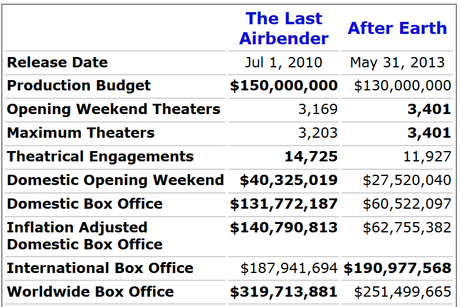
Still, Shyamalan persevered and took a crack at blockbuster filmmaking as well as producing, helming The Last Airbender and After Earth, producing 2010's low-budget The Devil and attaching his name to Fox's trippy TV series Wayward Pines. Neither blockbuster managed to make blockbuster-like money, Devil was profitable but not impressively so and Wayward Pines, which Shyamalan executive produced in addition to directing the pilot, enjoyed two moderately successful seasons on Fox. Shyamalan's future seemed to be in TV. Instead, he chose to build upon what he'd started with Devil, mounting his comeback as a horror/thriller director in the low-budget realm.
Shyamalan's Comeback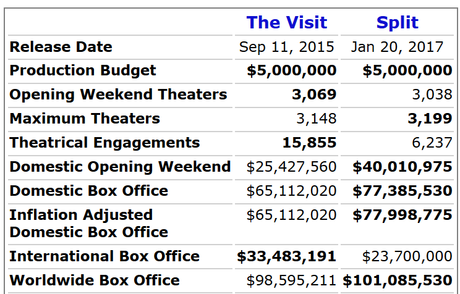
While Devil ultimately grossed five times its budget it was still hamstrung by its association with Shyamalan, whose name had become toxic and inspired laughter in theaters. The Visit, a modern day Hansel & Gretel for the found footage generation, had to be different. It was largely self-financed and filmed outside the studio system. In fact, it was filmed in secret, and sprung on us as a surprise, Jason Blum stepping in as distributor through Blumhouse's deal with Universal. You didn't have to know anything about Shyamalan to want to see the movie. Many younger audiences probably hadn't even heard of him. However, enough of them went to see it to turn The Visit into a nicely profitable movie.
Perhaps that's where the switch has truly occurred: profitability. The type of movies Shyamalan used to make either aren't actually made anymore or they aren't made at those old $40m-$70m budget levels. When the middle fell out of the industry and went to TV Shyamalan tried his hand at blockbuster filmmaking. After failing there, he so easily could have segued to TV. Instead, he has made two of his lowest-grossing films of all time, yet The Visit and Split constitute his wildly successful comeback because the expectations are so different now. They each cost $5m to make, and Visit grossed nearly $100m whereas Split is already there and climbing.
Shyamalan has adjusted to the new realities in Hollywood, and relaunched his career by successfully appealing to audience members who are too young to remember that one year where "I see dead people" was the pop culture phrase of the moment. Now, small movies might be all he does in the future, as he told ScreenRant :
"It really works for me. I can't say right now, definitively I'm always going to make small movies, but I would like to. That's what I feel like right now. I just want to make small movies forever. But then you'll read I'm making the next Star Wars and you'll say, 'He's an asshole!'"

